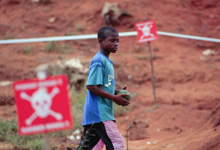Namibia Demining project

The Ruacana power lines, mined during the Namibian independence war by the South African armed forces, have been the scene of mine accidents time and again.

Anything that doesn’t explode while in the Rotar drum is loaded onto the bed of armoured tipper truck where it is inspected for mines and ammunition. The armoured inspection tower of the truck is clearly visible.
The Ruacana power lines
Since 1992 MgM has witnessed numerous attempts to clear the mine fields in the North of Namibia. These efforts have, for the most part, been substandard or have tragically failed.
In 1999 the first prototype of the ROTAR MKI was completed in Windhoek Namibia. The Board of Directors of MgM decided to evaluate its field utility in a series of tests at one of the most difficult projects in the Namibian mine clearing program.
The failed attempts of previous organizations had made the problem slightly worse than it would have been if the minefields had been undisturbed. There had been a particularly useless clearance effort that involved bulldozing the mined soil around the power pylons. This had left the situation extremely confused and dangerous. This was especially regrettable because the position of the mines had been marked on deployment maps handed over by the South-Africans and manual clearance would have been relatively simple before the bulldozers moved in.
In spite of the inadequate methods used, the area was declared clear. Almost immediately, accidents started to occur. The victims were often young herders and their cattle. Finally the authorities decided to mark the “mine free” earth mounds at the bottom of the pylons with warning signs - and then forget the problem.
In the presence of international observers in August 1999, MgM used the new ROTAR MK1 trial as an opportunity to successfully clear the mines under part of the power line.
The new clearance vehicle developed by MgM withstood it’s maiden test and demonstrated its competence well.
With a rotating drum the ROTAR sifted the ground beneath the masts – paying special attention to the bulldozed mounds which were found to contain numerous anti-personnel blast and fragmentation mines. These either exploded during the operation of the ROTAR drum or were removed by explosives specialists and destroyed later in a controlled environment.
Independent observers confirmed the success of this MgM mine clearance project, which is comprehensively documented on a CD-ROM. (The CD is available via dc@mgm.org)
Since then there has not been a mine accident in the part of the power line cleared by MgM.





